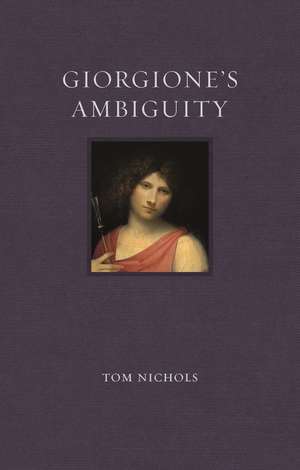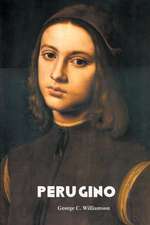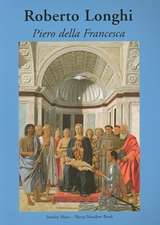Giorgione’s Ambiguity: Renaissance Lives
Autor Tom Nicholsen Limba Engleză Hardback – 24 dec 2020
Din seria Renaissance Lives
-
 Preț: 118.03 lei
Preț: 118.03 lei -
 Preț: 116.69 lei
Preț: 116.69 lei -
 Preț: 117.31 lei
Preț: 117.31 lei -
 Preț: 116.03 lei
Preț: 116.03 lei -
 Preț: 117.31 lei
Preț: 117.31 lei -
 Preț: 118.85 lei
Preț: 118.85 lei -
 Preț: 117.05 lei
Preț: 117.05 lei -
 Preț: 117.05 lei
Preț: 117.05 lei -
 Preț: 118.89 lei
Preț: 118.89 lei -
 Preț: 116.33 lei
Preț: 116.33 lei -
 Preț: 117.31 lei
Preț: 117.31 lei -
 Preț: 116.64 lei
Preț: 116.64 lei -
 Preț: 96.74 lei
Preț: 96.74 lei -
 Preț: 117.31 lei
Preț: 117.31 lei -
 Preț: 117.53 lei
Preț: 117.53 lei -
 Preț: 116.28 lei
Preț: 116.28 lei -
 Preț: 116.53 lei
Preț: 116.53 lei -
 Preț: 116.46 lei
Preț: 116.46 lei -
 Preț: 96.69 lei
Preț: 96.69 lei -
 Preț: 97.45 lei
Preț: 97.45 lei -
 Preț: 117.57 lei
Preț: 117.57 lei -
 Preț: 115.73 lei
Preț: 115.73 lei -
 Preț: 115.26 lei
Preț: 115.26 lei -
 Preț: 116.03 lei
Preț: 116.03 lei -
 Preț: 116.69 lei
Preț: 116.69 lei -
 Preț: 98.53 lei
Preț: 98.53 lei -
 Preț: 115.26 lei
Preț: 115.26 lei -
 Preț: 95.92 lei
Preț: 95.92 lei -
 Preț: 116.03 lei
Preț: 116.03 lei -
 Preț: 115.52 lei
Preț: 115.52 lei - 5%
 Preț: 110.76 lei
Preț: 110.76 lei -
 Preț: 115.05 lei
Preț: 115.05 lei -
 Preț: 96.95 lei
Preț: 96.95 lei -
 Preț: 97.97 lei
Preț: 97.97 lei -
 Preț: 114.75 lei
Preț: 114.75 lei -
 Preț: 114.75 lei
Preț: 114.75 lei -
 Preț: 114.75 lei
Preț: 114.75 lei
Preț: 116.39 lei
Nou
Puncte Express: 175
Preț estimativ în valută:
22.28€ • 22.86$ • 18.76£
22.28€ • 22.86$ • 18.76£
Carte disponibilă
Livrare economică 06-20 februarie
Livrare express 22-28 ianuarie pentru 34.66 lei
Preluare comenzi: 021 569.72.76
Specificații
ISBN-13: 9781789142976
ISBN-10: 1789142970
Pagini: 288
Ilustrații: 40 color plates, 20 halftones
Dimensiuni: 133 x 210 x 23 mm
Greutate: 0.6 kg
Ediția:Nouă
Editura: REAKTION BOOKS
Colecția Reaktion Books
Seria Renaissance Lives
ISBN-10: 1789142970
Pagini: 288
Ilustrații: 40 color plates, 20 halftones
Dimensiuni: 133 x 210 x 23 mm
Greutate: 0.6 kg
Ediția:Nouă
Editura: REAKTION BOOKS
Colecția Reaktion Books
Seria Renaissance Lives
Notă biografică
Tom Nichols is a reader in art history at the University of Glasgow. His previous books include Tintoretto: Tradition and Identity and Titian and the End of the Venetian Renaissance, both also published by Reaktion.
Recenzii
"Nichols contends that everything about Giorgione’s paintings—from their hazy brushstrokes and unconventional colors to their peculiar compositions and enigmatic figures—is meant to puzzle us, and thereby draw us in. . . . Although Giorgione’s biography and artwork are ambiguous, Nichols’s text is not. His survey of Giorgione’s portraits, landscapes, and nudes is evenly paced, meticulously researched, and persuasively argued. The author presents a lucid examination of what we do and do not know about Giorgione that ultimately opens the viewer to a richer engagement with the artwork. The book would appeal to scholars, artists, history buffs, and even Vasari himself."
"Systematic use of sfumato can have the effect of shrouding a painting in visual mystery, allowing space for a kind of reflection that’s unencumbered by the more routine task of identifying historical narrative, political figure, or religious doctrine. No painter used sfumato to this end more thrillingly than Giorgione, of the Venetian School, who died in his thirties in 1510, and to whom only a handful of existing works can be firmly attributed. Nichols’s book on Giorgione’s Ambiguity traces the life and work of this wonderfully enigmatic painter."
"Nichols's thesis that Giorgione's art is intended to expand the limits of art and our understanding of human nature is sound, well-researched and amply illustrated. Recommended."
"[A] brilliant biography and appraisal. . . . Hugely appealing . . . [and] should be investigated by all lovers of Renaissance men and Renaissance artists."
"Nichols’s book serves as an excellent, cerebral, and insightful essay on one of the most influential and enigmatic of Renaissance painters. Like one of Giorgione’s own pictures, Nichols’s analysis is lyrical, and thought-provoking; constantly drawn to the profound implications of its subject, yet never less than concise and accessible. The book is particularly welcome and timely. . . . Nichols is able to reserve his considerable intellectual energy for a revitalising and superbly informed discussion of the essence of Giorgione—both in terms of the elusive, enfolded meanings of his art, and in providing the reader with a navigable, clear-headed guide to a corpus of key works."





